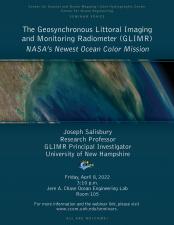The Geosynchronous Littoral Imaging and Monitoring Radiometer (GLIMR): NASA’s Newest Ocean Color Mission
UNH
This presentation centers on science enabled by the Geosynchronous Littoral Imaging and Monitoring Radiometer (GLIMR), a hyperspectral ocean color sensor capable of repeat coverage throughout the day. GLIMR data will help fill critical gaps in ecosystem and carbon cycle science, and it will be the first U.S. mission designed for resolving coastal and ocean ecosystem processes with short lifecycles ranging from minutes to several days. The GLIMR mission will open new fields of inquiry into phytoplankton dynamics, (including those that cause human health and economic harm), local and advective carbon and sediment exchanges, and the evolution of hazardous events such as harmful algal blooms and oil spills. Our datasets will be applied to further present knowledge of phytoplankton physiological processes, ecosystem production, inventories of biogeochemical constituents and time evolving processes influenced by tides, eddies, surface currents, and river plumes. The presentation will describe the mission and its ocean color instrument, discuss a day in the life of GLIMR and will give an update of progress to date and launch plans
As principal investigator of GLIMR, Joe is responsible for the success of the entire mission. His primary interest is in helping to facilitate the new science that will be enabled by having a hyperspectral ocean color sensor in a geostationary orbit. His research interests focus on the biogeochemistry and ecology of coastal regions, particularly those influenced by riverine processes. Presently, Joe is working on two strands of research. The first seeks to characterize distributions of carbon dioxide, air-sea carbon exchange, productivity and acid stress in freshwater-influenced coastal regions. The second strand involves the use of data from a variety of space-borne sensors to characterize net community productivity and carbon exchanges in coastal waters.





